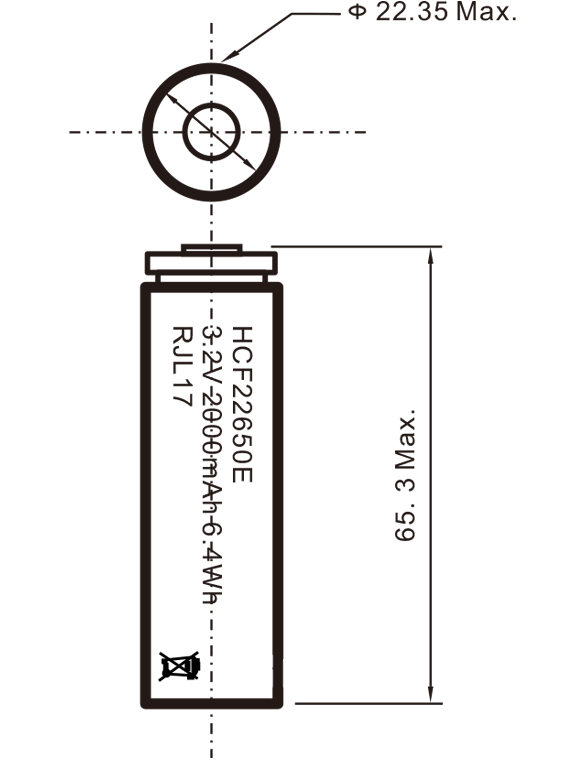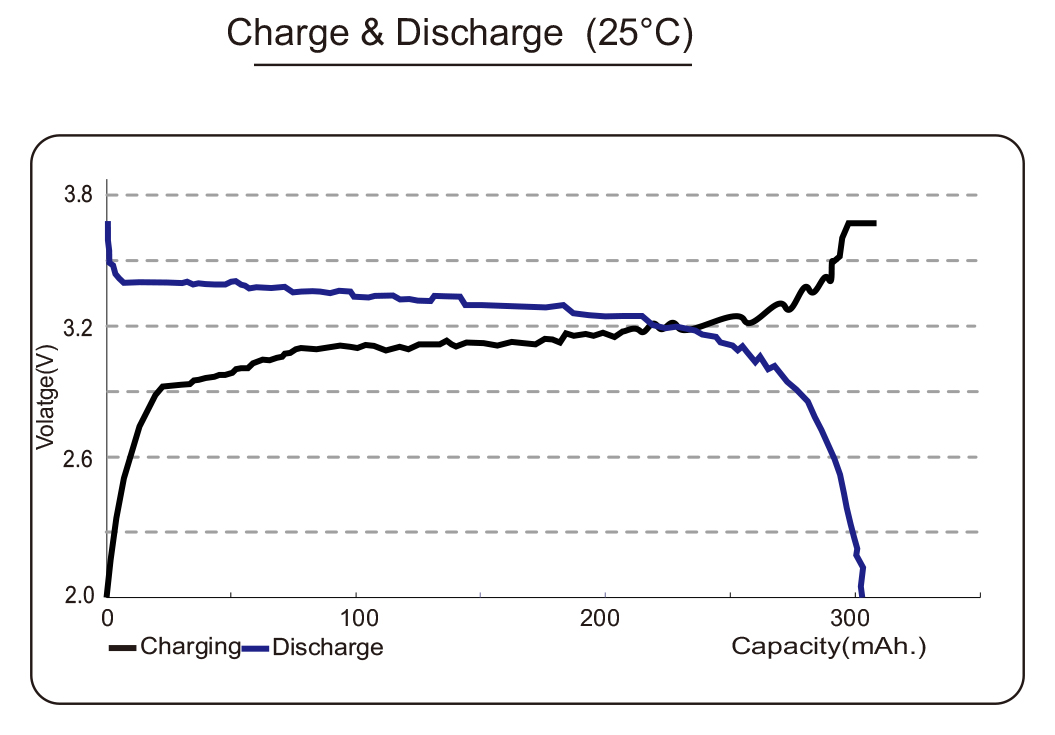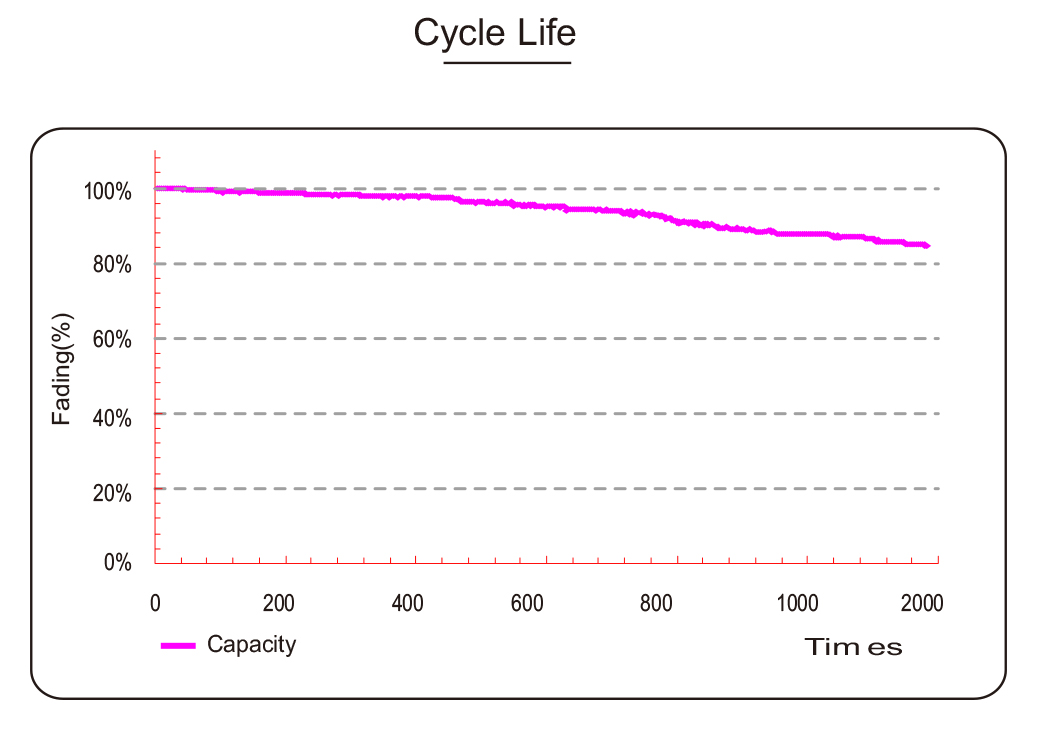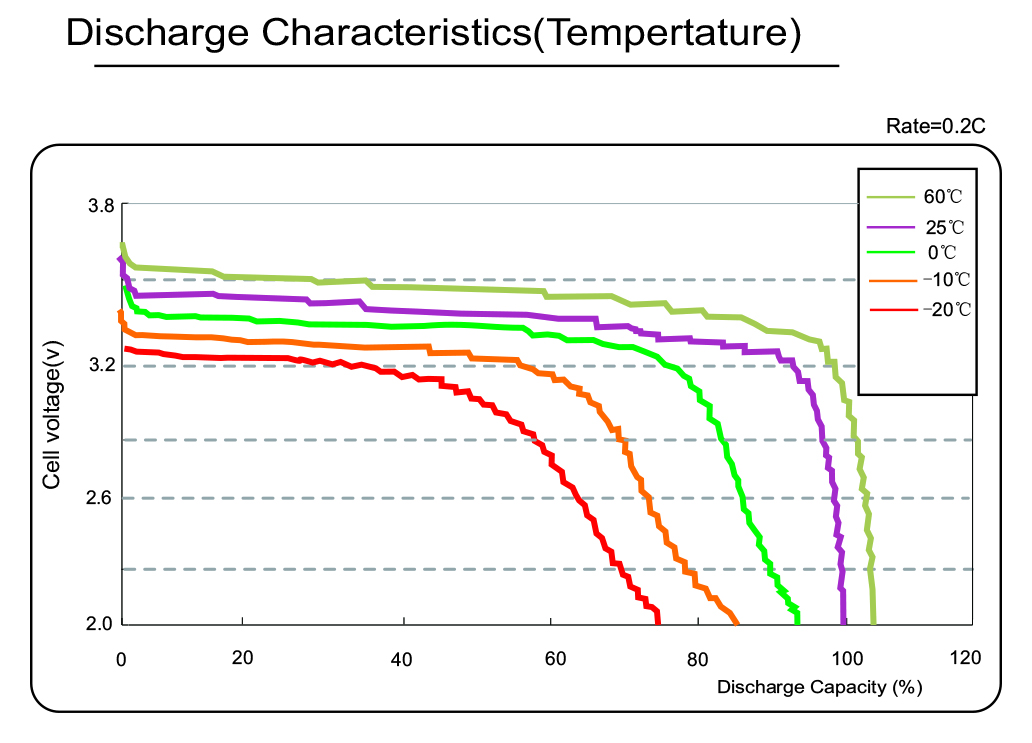 You are here; Home / Products / LiFePO4
You are here; Home / Products / LiFePO4 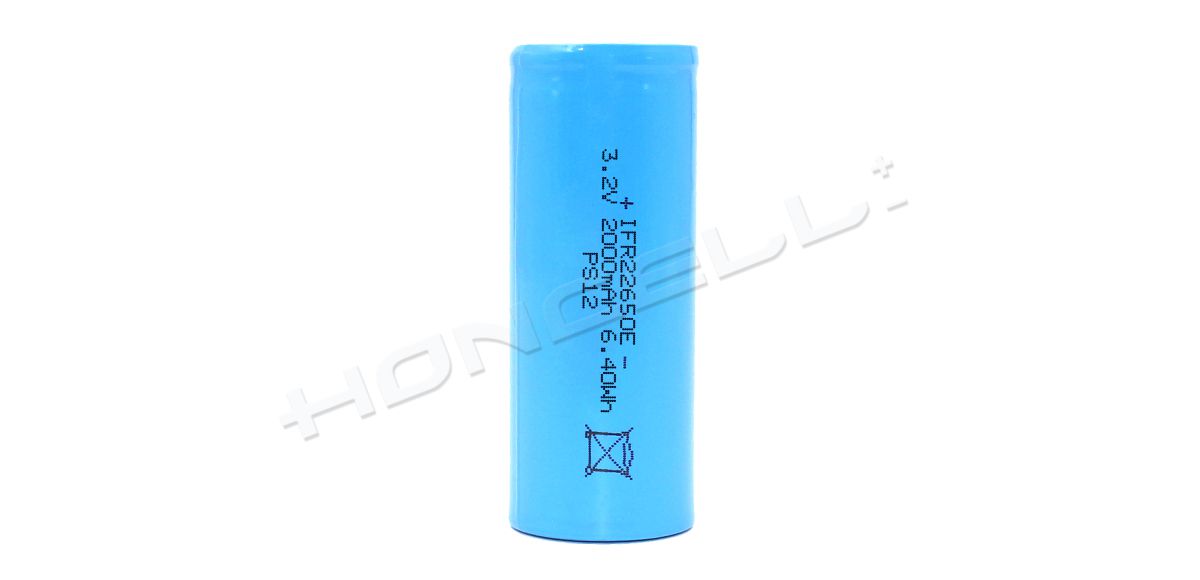

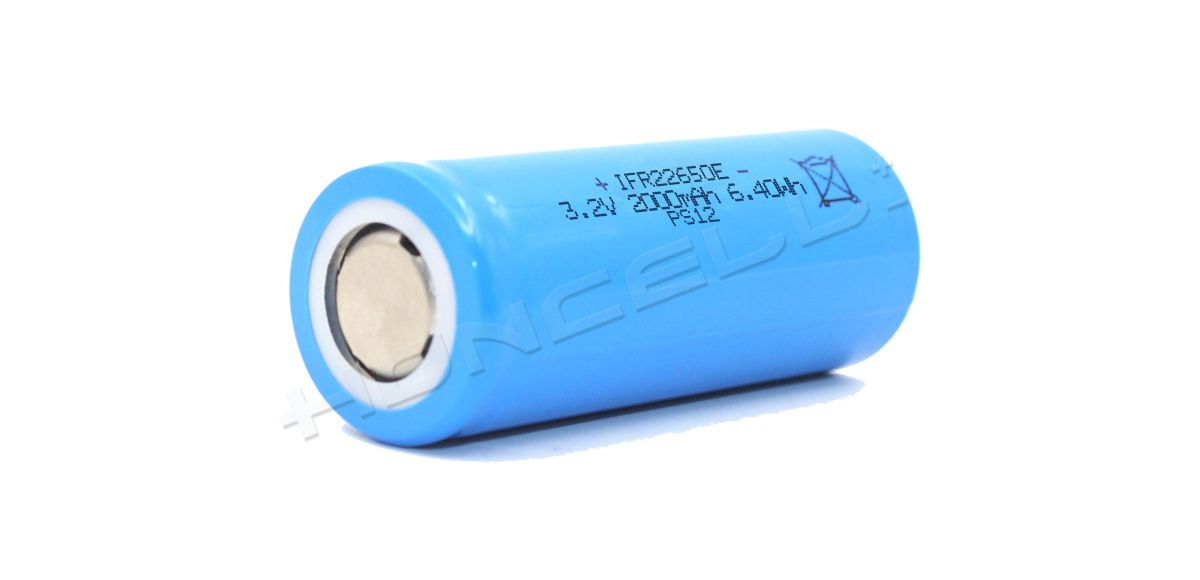




- Part Number: IFR22650E
- Configuration: IFR22650E-1S1P
- Cell Size Max. 22.15x65.0mm (D*H)
- Nominal Voltage: 3.2V
- Working Voltage: 2.0-3.65V
- Rated Capacity: 2000mAh
- Internal Impedance ≤60.0mΩ
- Constant Discharge Current: 0.2C(Standard) | 3C(Max )
- Working Temperature: charge: 0-45℃; discharge: -20-60℃
- Weight: 63.0g
- Lead wires: UL1571-AWG#22, length: 50mm
- Connectors: JST
- Over-charge Detected Voltage: 3.65±0.025V
- Over-discharge Detected Voltage: 2.0±0.05V
- Notify us if you prefer a charger specifically designed for Honcell Lipo batteries.
- Tell us if you prefer a schematic CAD file for Honcell Lipo battery packs.
LiFePO4 Lithium Iron Phosphate Cells
LiFePO4 technology is optimized for long life applications such as UPS, where battery life is more important than single cycle length. LiFePO4 cells are nominally 3.2 volt and offer 1200- 2,000 full charge / recharge cycles. They are available in various package types including; cylindrical 18650, 26650 sizes, a large range pouch style cell sizes, similar to lithium polymer and also as hard case large capacity cells. Cell capacities range from 30mAh to 12 Ah. We can provide packs with cells in series and parallel including safety and control electronics if required.
Honcell Lithium iron phosphate battery product series
These three images are cells, modules and finished products respectively, which were linked to cells, modules, finished products pages.
Lithium Iron Phosphate
This technology is suited to fast charge applications with longer cycle life of up to 2000 cycles. Available in 18650 and 26650 cylindrical cell sizes and also rectanglular hard case and soft case (similar to Lithium Polymer). This makes them suitable for applications requiring longer life and repeated fast charging. These include power tools, mobility products and other applications driving electric motors.
Focus is on safety and reliable performance. Patented cell designs and unique production techniques offer customers a high quality product at a competitive cost.
The LiFePO4 offers voltage of 3.2V which slightly lower than the LiCoO2 one, but with high rate discharging (5C or above) capability in a safer way. It could also perform well in a high temperature discharge when comparing with LiCoO2 chemistry. HONCELL LiFePO4 battery offers conventional cylindrical type to fit your application. LiFePO4 has the characteristics of safe, high energy density, stable discharge platform, long life time over 2000 cycle times and environment friendly.
Honcell is adapting an international mature cylindrical structure design and produce high consistency and stability Lithium iron phosphate battery by using the optimal battery material and processing concept.
At present the company research and development main single LiFePo4 cell IFR3265 capacity is between 5-6AH,from the first generation 5AH,to the second generation 5.5AH, to the moment the third generation 6AH.With the capacity increased continuously, the single cell the highest weight ratio up to 130Wh/kg, and the highest volume ratio up to 336WH/L. At the same time with the technology innovated and process improved, the battery consistency was greatly enhanced. It can be up to 4000 cycles and the service life up to 10 years under 100% DOD.
On this basis, we can provide power battery pack & storage energy battery & car starting system integration and a series and high efficiency lithium iron phosphate system solution with reliable structure design and powerful function of battery management system, which are mainly used for new energy automobile power system, mobile emergency power supply system, large energy storage backup power system and other fields.
Besides, Our company also produce 26650,22650,18650 and other types LiFePOo4 cells for emergency lighting and other small energy storage.
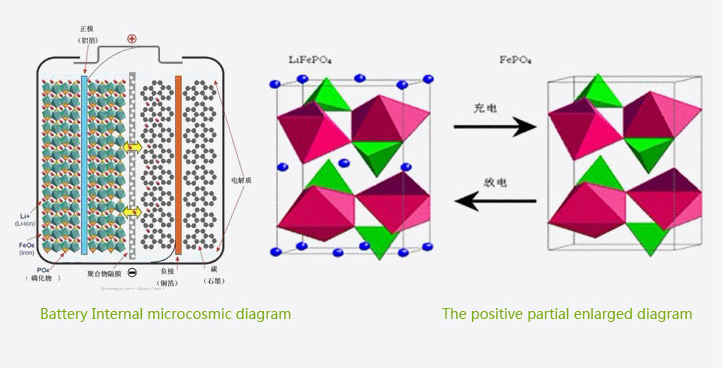
Lithium iron phosphate batteries high safety crystal structure
The crystallization of the lithium iron phosphate material is an olivine structure, all oxygen atoms binding with the phosphorus atom tough a strong covalent bond to form PO43,Even in the fully charged state, oxygen is kept well. It have an excellent stability and safety performance.
It stable performance can be up to 400-500℃ under high temperature(when abused it release less capacity in high temperature, which keep its interior good safety performance, thus it would not get exploded or burned under overcharging, overheating, short circuit and clash.
LiFePO4 battery has good thermal stability when heating and there is less oxidation of the electrolyte, it improved LiFePO4 battery's tolerance to overcharge, compared with other batteries.
The lithium iron phosphate (LiFePO4) battery, also called LFP battery (with "LFP" standing for "lithium ferrophosphate"), is a type of rechargeable battery, specifically a lithium-ion battery, which uses LiFePO4 as a cathode material. LiFePO4 batteries have somewhat lower energy density than the more common LiCoO2 design found in consumer electronics, but offers longer lifetimes, better power density (the rate that energy can be drawn from them) and are inherently safer. LiFePO4 is finding a number of roles in vehicle use and backup power.
The LiFePO4 battery uses a lithium-ion-derived chemistry and shares many advantages and disadvantages with other Lithium-ion battery chemistries. However, there are significant differences.LFP chemistry offers a longer cycle life than other lithium-ion approaches. Like nickel-based rechargeable batteries (and unlike other lithium ion batteries), LiFePO4 batteries have a very constant discharge voltage. Voltage stays close to 3.2V during discharge until the battery is exhausted. This allows the battery to deliver virtually full power until it is discharged. And it can greatly simplify or even eliminate the need for voltage regulation circuitry. Because of the nominal 3.2V output, four batteries can be placed in series for a nominal voltage of 12.8V. This comes close to the nominal voltage of six-cell lead-acid batteries. And, along with the good safety characteristics of LFP batteries, this makes LFP a good potential replacement for lead-acid batteries in many applications such as automotive and solar applications. The use of phosphates avoids cobalt's cost and environmental concerns, particularly concerns about cobalt entering the environment through improper disposal.[6]
LiFePO4 has higher current or peak-power ratings than LiCoO2. The energy density (energy/volume) of a new LFP battery is some 14% lower than that of a new LiCoO2 battery.[8] Also, many brands of LFPs, as well as cells within a given brand of LFP batteries, have a lower discharge rate than lead-acid or LiCoO2. Since discharge rate is a percentage of battery capacity a higher rate can be achieved by using a larger battery (more ampère-hours) if low current batteries must be used. Better yet, a high current LFP cell (which will have a higher discharge rate than a lead acid or LiCoO2 battery of the same capacity) can be used. LiFePO 4 cells experience a slower rate of capacity loss (aka greater calendar-life) than lithium-ion battery chemistries such as LiCoO2 cobalt or LiMn2O4 manganese spinel lithium-ion polymer batteries or lithium-ion batteries.[9] After one year on the shelf, a LiFePO4 cell typically has approximately the same energy density as a LiCoO2 Li-ion cell, because of LFP's slower decline of energy density. Thereafter, LiFePO4 likely has a higher density.
Safety
One important advantage over other lithium-ion chemistries is thermal and chemical stability, which improves battery safety.[6] LiFePO4 is an intrinsically safer cathode material than LiCoO2 and manganese spinel. The Fe-P-O bond is stronger than the Co-O bond, so that when abused, (short-circuited, overheated, etc.) the oxygen atoms are much harder to remove. This stabilization of the redox energies also helps fast ion migration. As lithium migrates out of the cathode in a LiCoO2 cell, the CoO2 undergoes non-linear expansion that affects the structural integrity of the cell. The fully lithiated and unlithiated states of LiFePO4 are structurally similar which means that LiFePO4 cells are more structurally stable than LiCoO2 cells. No lithium remains in the cathode of a fully charged LiFePO4 cell—in a LiCoO2 cell, approximately 50% remains in the cathode. LiFePO4 is highly resilient during oxygen loss, which typically results in an exothermic reaction in other lithium cells. As a result, lithium iron phosphate cells are much harder to ignite in the event of mishandling (especially during charge) although any fully charged battery can only dissipate overcharge energy as heat. Therefore, failure of the battery through misuse is still possible. It is commonly accepted that LiFePO4 battery does not decompose at high temperatures.[6] The difference between LFP and the LiPo battery cells commonly used in the aeromodeling hobby is particularly notable.[citation needed]
µ Transportation
µ Engine Start System
µ Telecommunication Station
µ Energy Storage
µ High Performance: high theoretical capacity of 170mah/g and high practical capacity as high as 165mah/g
µ Long Cycle Life: up to 2000 cycle life (8x of Lead Acid and 3-4x of Li-ion)
µ Extremely Safe/Stable Chemistry: no explosion & will not catch fire under collision over charged or short circuit; hi thermal stability of phases up to 500C
µ Long Service Life: Around 5~6 years
µ Wide working temperature range: From -4 F to 150 F (-20℃ to +70℃)
µ Flexible & Small Form Factor: 1/3 weight of lead acid and 64% of NiMH
µ High Rate (Power) Capability
µ Environmentally Friendly Non-toxic, non-contaminating and No rare metal
µ Fast Charging: fully charged in a very short time ---2C fast charge within half hour
µ High stability: steady structure of battery cell, rigorous combination design, powerful BMS(Battery Management System), all of that make sure battery with stable performance permanently
µ Good safety performance: rule of three security: Double security for single battery cell, Safety protection for pack, Advance protection from BMS(Battery Management System. No explosion and burning after safety testing like overcharging/discharging, short circuit, dropping, squeezing, heating, penetrating
µ Long cycle and service term: 1C charge/discharge, 100% discharge of depth, 2000 cycle discharge/charge cycles. Service term above 8 years
µ Economic: To compare with using fuel oil, it can reduce 70% cost for every bus each year
µ Environment friendly: Optimum LiFePO4 battery has great efficiency for energy conservation and emission reduction, and without any hazardous and noxious substances
The purpose of a battery pack is to provide a convenient integrated power source for portable applications.
The pack may fulfill several functions:
· It enables higher voltage or higher capacity batteries to be built up from low voltage, low capacity cells.
· It houses a cell or a bank of cells together with the associated interconnections in a single convenient pack.
· It accommodates any necessary monitoring and electronic protection devices or circuits within the pack.
· It can accommodate additional circuitry such as indicator lights, heaters, cooling ducts and solar panels.
· It matches and meshes with the cavity in the product which the battery is intended to power providing both electrical and mechanical interfaces.
· It can provide unique electrical and mechanical interfaces to ensure compatibility both of the battery with the intended product and the charger with the battery.
With a simple series chain of cells, high battery voltages are achieved by adding more cells in a series chain. This does not increase the Amp Hour capacity of the battery , but it increases the Watt-hour capacity, or the total stored energy, in proportion to the number of cells in the chain. The battery capacity can be increased through adding more parallel cells. This increases the Amp Hour capacity as well as the Watt-hour capacity without increasing the battery voltage. Whereas cell voltage is fixed by the cell chemistry, cell capacity depends on the surface area of the electrodes and the volume of the electrolyte, that is, the physical size of the cell. If at all possible the number of cells in a pack should be minimized to simplify the design and to minimize potential reliability problems. Fewer cells require fewer support electronics. It must be pointed, cells with different capacities or cell chemistries should not be mixed in a single battery pack. We can help your designs are safe, cost efficient and suitable for your application with advices.
The voltage of a single Li-poly cell varies from about 2.7 V (discharged) to about 4.23 V (fully charged), and Li-poly cells have to be protected from overcharge by limiting the applied voltage to no more than 4.235 V per cell if in a pack or not. All batteries can include a protection circuit module (PCM) with short circuit, over charge / discharge protection, matched to your application requirements. Add temperature sensing (NTC) and and other control features (PPTC).
The lipo batteries can come pre-attached with a genuine x-pin(x=2 or 3 or 4) connector in lead wires drawn out from the included necessary protection circuit module ( PCM ). Because they have a genuine connector, not a knock-off, the cable won't snag or get stuck in a matching JST jack, they click in and out very smoothly. The included protection circuitry keeps the battery voltage from going too high (over-charging) or low (over-discharge) which means that the battery will cut off when completely dead at 3.0V or 2.75V on the basis of pre-selected type of PCM. It will also protect against output shorts. However, even with this protection it is very important that you only use a charger specifically designed for lithium ion polymer batteries in CC( constant-current) / CV (constant-voltage) to recharge them and at a rate of 0.5C or less.
Like most lipo batteries, the packs we are making have no NTC thermistors built in. This is why we suggest charging at lower current. We can definitely say charging at 0.2C is always a good rate, and available from any USB port if using a USB-powered charger.
If your application requires a removable or replaceable battery, we are good enough to manufacture the complete product including battery and hard plastic case as a whole "hard case battery".






